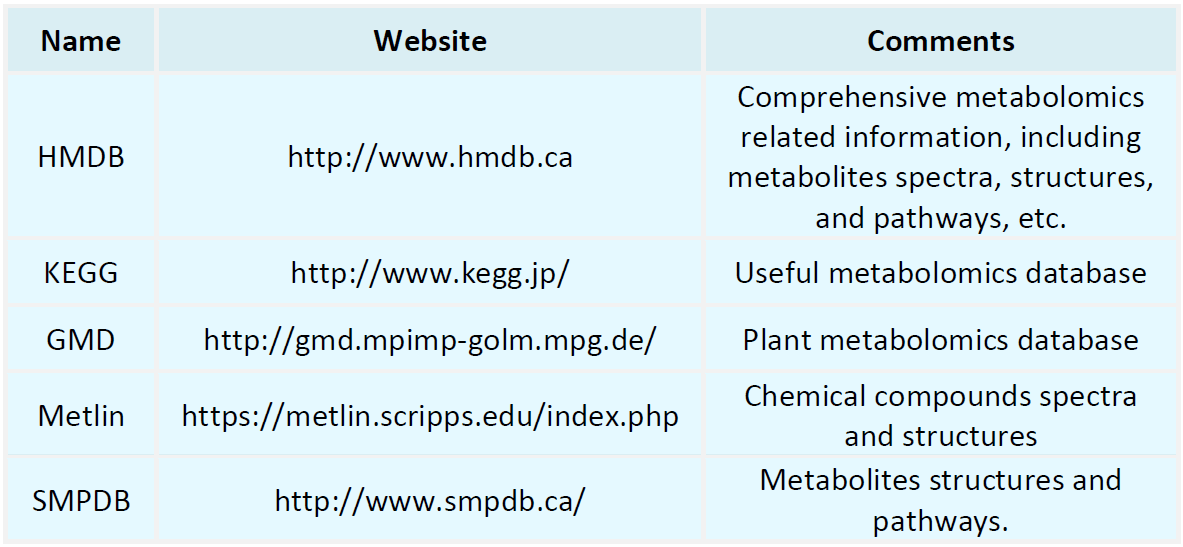Resources
Proteomics Databases

Metabolomics Databases

-
• X-Ray Crystallography to Determine Protein Structure
X-ray crystallography to determine protein structure is a crucial method for elucidating the three-dimensional structures of proteins, which is fundamental to understanding their functions, as structure dictates function. With its high resolution and accuracy, X-ray crystallography is a preferred approach for structural studies. The method involves analyzing X-ray diffraction patterns of protein crystals to generate an electron density map, which is then used to construct a three-dimensional structura......
-
• Vegan Protein Amino Acid Profile
The vegan protein amino acid profile refers to the composition and content of amino acids in plant-based proteins, which can vary significantly depending on the source. Research on these profiles primarily focuses on the precise analysis of amino acid types and their proportions. Vegan proteins can meet human requirements for high-quality protein while contributing to reduced greenhouse gas emissions and land use. However, the amino acid composition of vegan proteins differs markedly from that of anim......
-
• Vegan Protein Powder Complete Amino Acid Profile
The vegan protein powder complete amino acid profile is a comprehensive analytical process that detects and evaluates all amino acid components present in plant-based protein powders. This analysis focuses on identifying the types, concentrations, and ratios of amino acids to assess the nutritional value and overall suitability of vegan protein powders. With the increasing emphasis on health awareness and the growing popularity of vegetarian and vegan diets, the evaluation of the nutritional profile o......
-
• Circular Dichroism Spectroscopy Calculates the Secondary Structure Content of Proteins
Circular Dichroism Spectroscopy is a widely used technique for the characterization of protein secondary structures. By analyzing the absorption spectra of proteins in the ultraviolet region, information on the secondary structure composition—comprising α-helix, β-sheet, β-turn, and random coil—can be obtained.
-
• Are X-Ray Magnetic Circular Dichroism and Circular Dichroism the Same
Although X-ray Magnetic Circular Dichroism (XMCD) and Circular Dichroism (CD) are both critical techniques for analyzing the electronic properties of materials, they measure different physical quantities and are applied in distinct fields. Circular Dichroism (CD) primarily serves as a method for studying molecular structures, with significant applications in the fields of biological macromolecules and supramolecular chemistry. By assessing the differential absorption of left and right circularly polarized..
-
• Sialic Acid Content Detection
What is Sialic Acid: Sialic acid is a family of derivatives of neuraminic acid commonly found in human oral secretions, including saliva. It plays a critical role in maintaining oral health and reflects the body's metabolic balance. Saliva containing sialic acid helps maintain oral moisture, facilitates the chewing and digestion of food, protects the oral mucosa, and reduces the risk of oral diseases.
-
• Isoelectric Point Detection of Collagen Protein
Collagen is an abundant protein present in the skin, bones, tendons, and ligaments of mammals. Its primary function is to provide structural support and strength. The isoelectric point (pI) represents the pH at which a protein's positive and negative charges are balanced, resulting in a net charge of zero. This parameter is crucial for collagen, as it influences the protein's solubility and stability.
-
Cellular gene double knockout is a highly effective biotechnology method for exploring gene functions and their interactions. This approach involves the simultaneous inactivation of two distinct genes within the same cell. Methods for Double Knockout: The CRISPR-Cas9 system is the most commonly employed technique for achieving double knockouts. This precise gene-editing tool enables targeted cleavage of DNA and facilitates subsequent repair to delete or replace specific sequences. In double knockout........
-
• Hyaluronic Acid Molecular Weight Detection
Hyaluronic acid molecular weight determination is a pivotal and efficient scientific procedure used to ascertain the molecular weight of hyaluronic acid (HA), also known as hyaluronan. HA is a polysaccharide extensively found in various human tissues, particularly in synovial fluid and ocular regions. It exhibits multiple physiological roles, such as hydration, lubrication, and the promotion of cellular proliferation and differentiation. The molecular weight of HA significantly influences its functional....
-
• Can a Dynamic Light Scattering Particle Size Analyzer Test Polymers
Dynamic light scattering (DLS) particle size analyzers are extensively employed in the characterization of polymers. These instruments are primarily designed to determine the particle size distribution of microparticles or macromolecules, including proteins and polymers, within solutions or suspensions. By analyzing the Brownian motion of particles present in a sample, one can accurately estimate particle sizes. Consequently, DLS is highly applicable in polymer research, such as determining the size distrib
How to order?







